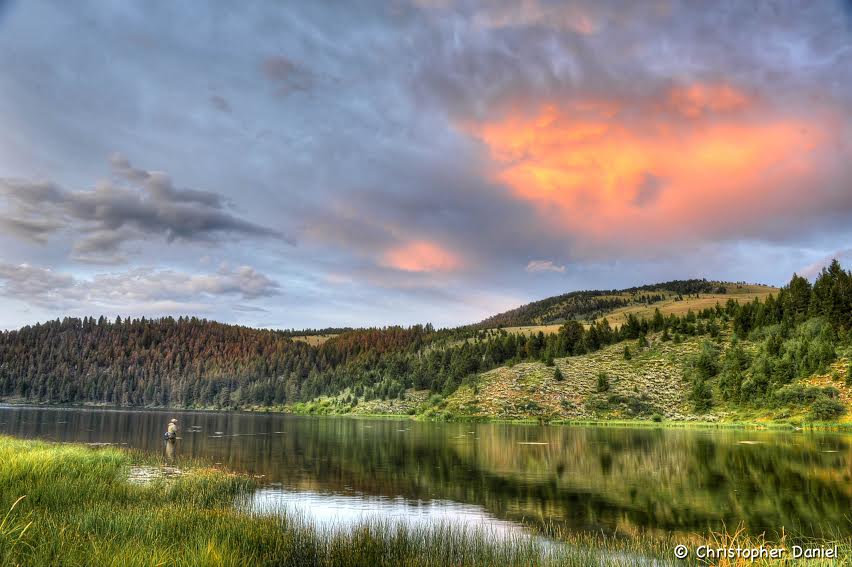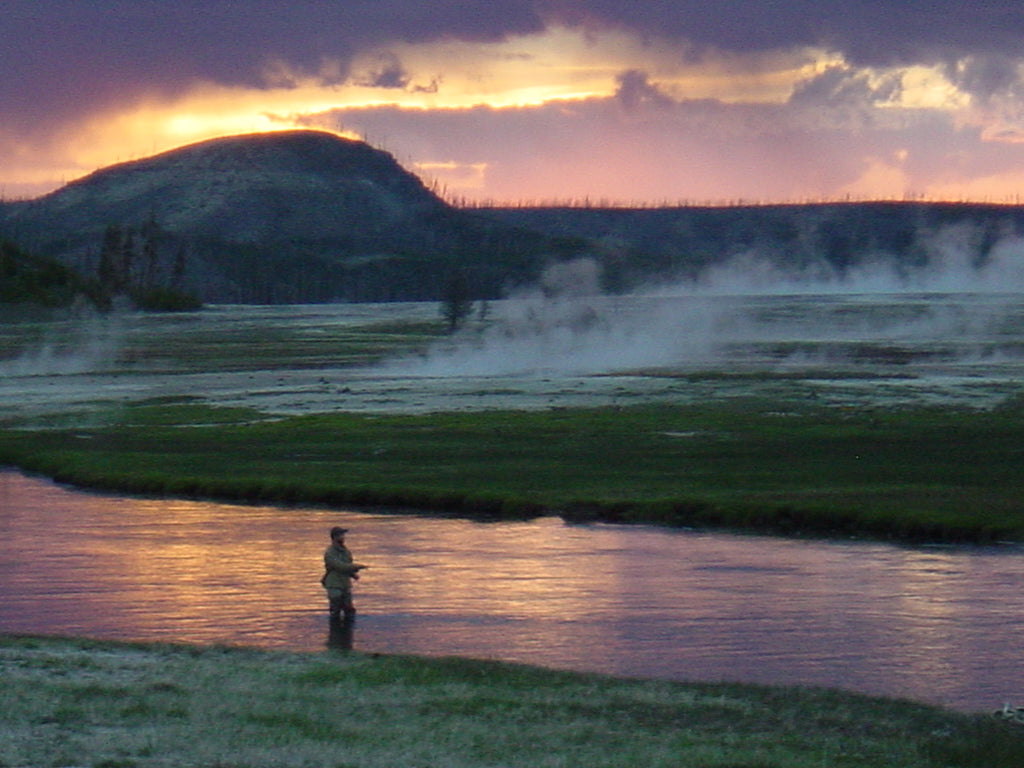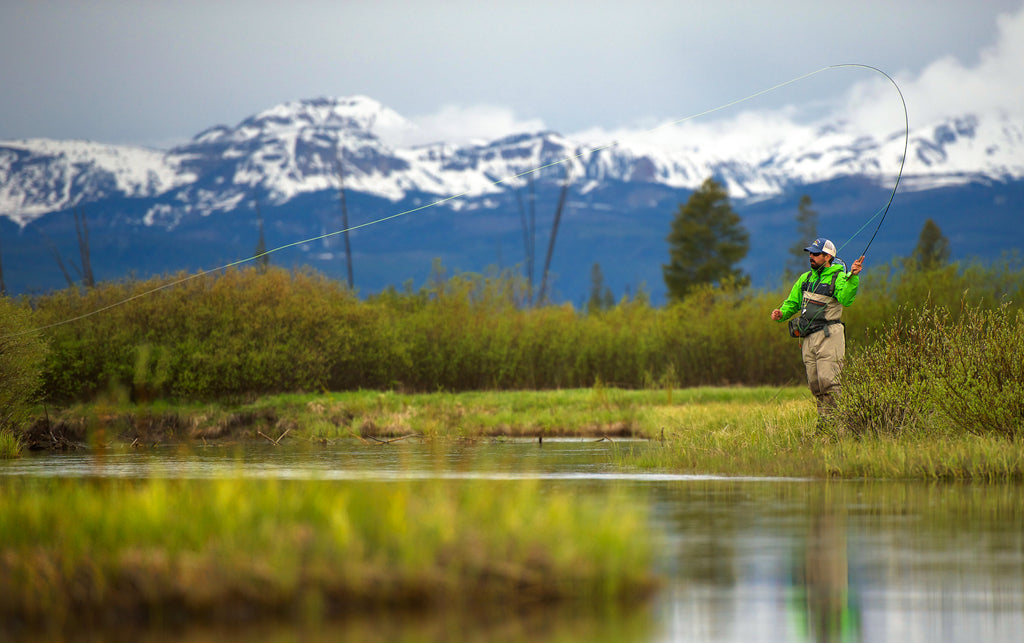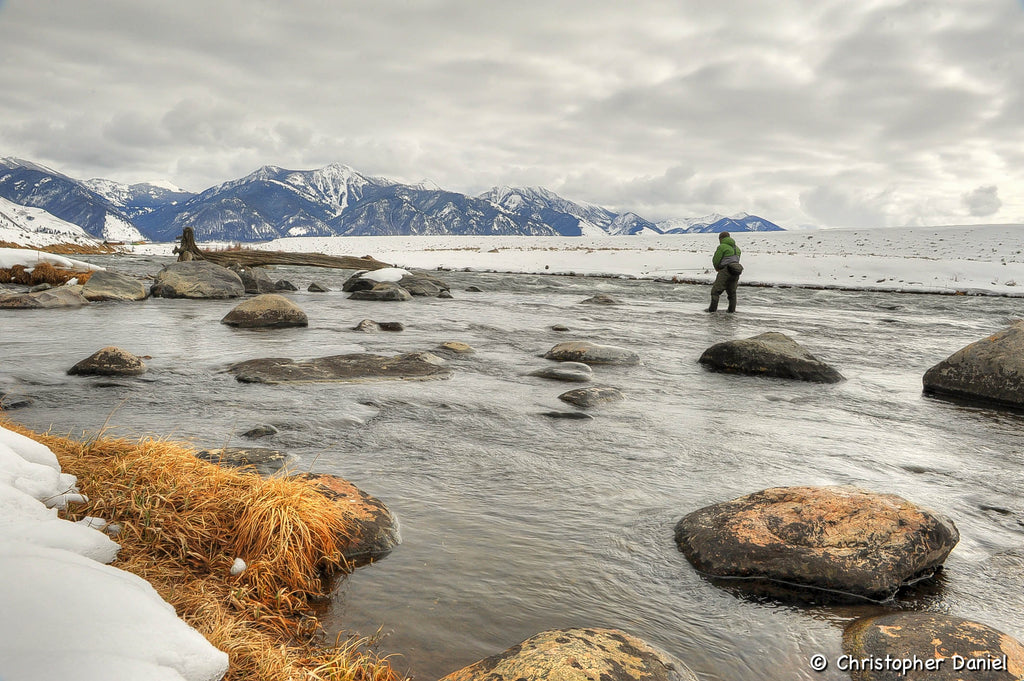Our Fly Fishing Seasons

In addition to being the west entrance to Yellowstone National Park, West Yellowstone offers anglers a wonderfully varied trout fishing experience throughout the year. While other locations offer good fishing on one fishery, West Yellowstone is centrally located to sample many world class rivers, lakes and small streams throughout Southwestern Montana and Yellowstone National Park. One could fish throughout the season and look at new water every day. This alone makes West Yellowstone unique as an angling destination, but this isn’t the only reason to fish the area. All of the trout in the surrounding rivers are wild as neither Montana nor Yellowstone Park stock trout in rivers. Native Cutthroats, Rainbows, Brown Trout, Brook Trout, Lake Trout, Native Rocky Mountain Whitefish and even Native Grayling are all available to a fisherman at times in the year.
SPRINGTIME

Late March Through The Middle Of June
Our season kicks off in the spring with good fishing on the Gallatin and Madison between Hebgen Lake and Quake Lake in late March and April. Most of the early season fishing is with nymphs, though midge hatches and Baetis hatches can make for decent dry fly fishing. As the temps begin to warm in May things really pick up. Early in May the Madison provides good fishing below Lyon Bridge for guided float trips.
When Memorial Day comes, Yellowstone Park and the Henry’s Fork of the Snake provide anglers with additional options for great fishing. The Firehole is normally the focal point of the early season fly fishing in the Park, and Box Canyon sees Salmon Flies as it opens. Few rivers on earth match the Firehole for picturesque beauty, and the smallish trout that inhabit the river make for superb early season dry fly fishing. Caddis, Baetis and PMD’s hatch in numbers that at times can be almost unbelievable. During non-hatch periods, swinging soft hackles and nymphing can be a lot of fun as well. Run off affects most of our fisheries in June. The Firehole stays clear and fishable and Madison inside of Yellowstone normally clears very quickly in June. The Madison below Quake Lake is often high during this time, but visibility remains good until the West Fork of the Madison enters the river. This makes for about eight miles of prime water that fish very well through the high water period. Hebgen Lake can fish very well in May and June and Chironomid hatches get the fish on the bite. The Henry’s Fork also remains clear during this time.
EARLY SUMMER

Late June Through Mid July
By the last week in June, the Madison is dropping and the biggest hatch of the season is about to commence. Salmon Flies make their way up the river and are available to fisherman until just after the Fourth of July. These big bugs can provide phenomenal fishing on the Madison. Floating the river in a drift boat is the ideal way to find fish keyed into the big bugs. A day with a guide often begins with good nymphing in the morning hours. As one progresses downriver, the dry fly bite normally picks up by lunch time and dry fly fishing is the status quo for the afternoon. Once July rolls around, the Madison is seeing huge hatches in the evening hours of Caddis, PMD’s, Golden Stones, Flavs and Mayfly spinners in addition to the Salmon Flies which continue to make their way upriver. Fish in the Madison are keyed into surface flies after the Salmonfly hatch and most of our fishing throughout the summer is with dry flies.
The Gallatin River is normally clearing and dropping by July 4th and it too sees Salmon Flies. Dry fly fishing with attractors makes the Gallatin a great destination as soon as it clears and the fishing remains strong throughout the summer. Fishing on the Firehole begins to slow towards the end of June and comes to a screeching halt once we get hot days in July. The Gibbon provides good fishing later in the season as does the Gardner River in the Park. Slough Creek can begin to clear by July 4th but the Lamar and Soda Butte often remain high and off color from run off until later in the summer. These rivers can clear and drop by the 15th of July, but big snow years can push this back into August. By July, our fisheries are dry fly destinations for the most part as hatches on our rivers are at their peak and fish commonly respond better to surface fishing than to nymphs.
MID SUMMER

Mid July Through Mid August
The summer months see good dry fly fishing on all of the area rivers and increasing insect activity on the many lakes which offer good fishing. It is a superb time to hike to backcountry fisheries as the small mountain streams are warming, trails have dried out and fishing can be excellent on these out of the way rivers. The small streams in the area are at their best at this time of year and these places are a lot of fun to fish dries to smaller trout. The Madison in Montana remains the focal point for much of our fishing, as few fisheries in the area can match the fish present in the river. The Gallatin remains a great place to fish, both inside of Yellowstone and in Montana. Both rivers have great evening dry fly fishing most nights as Caddis and Mayfly spinners are consistently on the water throughout the midsummer period. During the day, attractor dry fly fishing is the norm. By mid summer inside of Yellowstone the rivers in the Northeast corner of the park are the main fishing attraction. Slough Creek, Soda Butte and the Lamar offer great fishing to large Native Cutthroats, along with unmatched scenic backdrops in this part of Yellowstone. These rivers are primarily dry fly streams as the Cutthroat are very surface orientated. Midges, terrestrials, PMD’s, Baetis, Grey Drakes and Caddies make for selective fish, though attractor fishing can also be effective when few insects are on the water.
The Yellowstone River opens below Yellowstone Lake on July 15th. The river between Fishing Bridge and Hayden Valley was recently one of the best trout fisheries in the world. Cutthroat numbers have plummeted in recent years and visiting anglers are often shocked by the lack of fish in this section of the Yellowstone compared to ten years ago. Lake Trout predation in Yellowstone Lake, Whirling Disease and low water seemingly are the three factors to blame on this fishery’s decline. The Yellowstone does still have some trout in it however, and these fish are larger now than ever before. It is no longer a numbers fishery, but it is a place to stalk a big rising cutthroat or two and catching a 20 inch Cutthroat on a dry is within the realm of possibility. However, many feel that the river should be closed to fishing to place as little stress on the remaining fish as possible, and they may well be right. Is fishing the Yellowstone ethical? That is for you to decide.
Mid summer begins the famous “Gulper” fishing on Hebgen and Quake Lakes. Callibaetis and Trico Mayflies are the reason for this unique fishing as fish key on the morning hatches of mayflies and eat spinners on the water’s surface. Gulper fishing is never an easy prospect. The Rainbows and Brown Trout in Hebgen and Quake Lakes are difficult approach and tough to fool with an imitation. It is the challenging nature of this fishing which is so attractive to many as well as the rewards of fooling these large and powerful fish. Nymphs, emergers, dries and spinner patterns all have their place in the Gulper fishers’ arsenal and many anglers come to West Yellowstone especially to meet this challenge.
LATE SUMMER

Mid August Through Mid September
Late summer is the time when terrestrials are the primary item on the menu in the rivers surrounding West Yellowstone. The first cool weather of the year normally strikes during the late summer but seldom lasts for more than a few days. Through there is still plenty of angling traffic at this time, the streams do thin out just a little bit. The Madison River below Quake Lake continues to fish well through the late summer period. Fish seem a little wiser this time of year and longer drifts, more careful fly selection and a quieter approach make a big difference on the rivers throughout the area. Cool mornings in late summer can often keep fish off of the surface bite until the water warms, but nymphing is normally good at these times. Fish are scattered throughout the river so it is wise to cover a lot of water and keep moving. Good terrestrial fishing can be found on the Gallatin, Gibbon and Gardner Rivers inside of Yellowstone. The Northeast Corner of Yellowstone however is the top destination in the Park in the late summer. This is the peak time to fish the Lamar, Slough Creek and Soda Butte. Hatches of Mahogany Duns, PMD’s, Baetis and Drakes keep the fish eyeing the surface and fishing attractors and terrestrial patterns is often very effective. Gulper fishing on Hebgen and Quake remains strong in the late summer and Callibaetis can be found on the water so long as the weather remains warm in September.
AUTUMN

Mid September Through The First Weekend in November
Autumn is a special time in Yellowstone and a fine time to fish in the rivers in the area. The Madison in Montana remains a featured destination, but it is rivaled as the fall rolls on by the Madison inside of Yellowstone. The Firehole once again begins to fish well as things cool down. Good fishing can still be found in the Northeast Corner of Yellowstone, but as September turns to October, the west side of Yellowstone Park is the place to find the best action.
Fall fishing on the Madison in Montana is mostly nymphing. Small Baetis nymphs make up a great deal of the trout’s diet and larger stonefly nymphs once again become attractive to the fish. Streamer fishing really picks up as the weather worsens and the nastiest days in the fall can be great for fishing big flies. Inside of Yellowstone the Madison begins to see some special fish by mid September. Lake-run browns and rainbows enter the river in increasing numbers as the month goes on and their numbers peak in October. These fish average 16-18 inches and larger fish are not out of the realm of possibility. This is purely a subsurface fishery and the larger fish are targeted by swinging soft hackles and streamers, dead drifting nymphs and streamers and stripping streamers in the deeper runs in the Park. As the water begins to cool in the Firehole, fish become more active. Caddis hatches provide good dry fly fishing in the evenings, but the biggest event on the Firehole is Baetis hatches. Cloudy, rainy days bring out the biggest emergence of these mayflies and pods of rising fish can be found eating with gluttony during the heavy hatches. It often seems that the worst weather brings out the best fishing on the Firehole in the fall.
WINTER

November Through Late March
After the lakes and rivers in Yellowstone National Park close to fishing following the first weekend in November there is still good fishing to be had in the West Yellowstone area. The Madison River between Hebgen Lake and Quake Lake remains open throughout the year as does the Madison River below Quake Lake. Increasing snow levels make river access troublesome and the cold can be severe. Fishing however, can be excellent. Often the best fishing is in the middle of the day. Midge hatches get going in December and can often bring out rising fish throughout the winter. Nymphing can be a lot of fun when the fish aren’t rising and the trout in the Madison feed on nymphs surprisingly well in the winter.
OTHER ACTIVITIES

For visitors who are not interested in fly fishing, the Park and surrounding National Forests have countless miles of scenic hiking trails. Yellowstone is a phenomenal location to view wildlife varying from Trumpeter Swans and Bald Eagles to Bison and Grizzly Bears. Yellowstone’s geology is varied and fascinating. Photographers delight in both the vivid scenery and abundant animals. Endless trails are available in the Gallatin and Beaverhead National Forests for mountain biking or horseback riding. There is great rafting to be found on the Gallatin, Snake and Yellowstone Rivers. No matter what your interests, West Yellowstone is a great location to enjoy the outdoors.
Contact Us if you having any questions about our fishing seasons or would like to book a trip with Madison River Outfitters.








